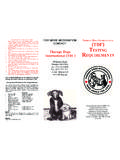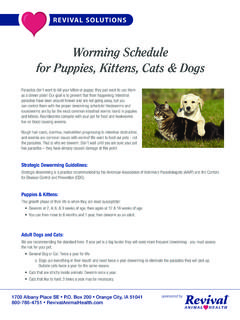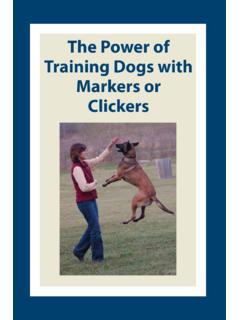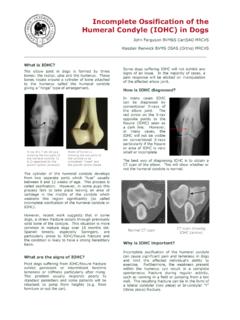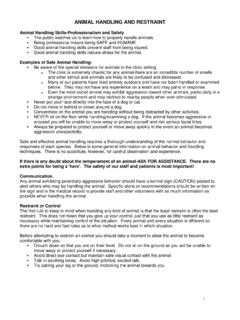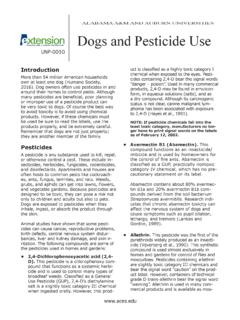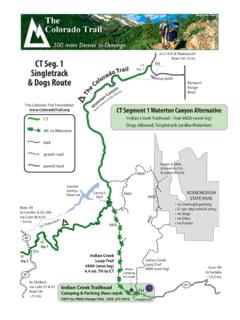Transcription of Topic: Search, Seizure, and Dogs “Attacking K-9 Evidence”
1 Texas Criminal Defense Lawyers Association Cross Examination April 26-27, 2012. Crown Plaza Hotel Dallas, Texas Topic: search , seizure , and dogs Attacking K-9 Evidence . Speaker: Donald H. Flanary, III. Goldstein, Goldstein & Hilley 310 South St. Mary's Street, Suite 2900. San Antonio, Texas 78205. email website 6808 Hill Meadow Dr :: Austin, Texas :: p :: f :: search , seizure , and dogs Attacking K-9 Evidence . Cross Examination Texas Criminal Defense Lawyers Association Dallas, Texas April 27, 2012. Presented by: DONALD H.
2 FLANARY, III. GOLDSTEIN, GOLDSTEIN & HILLEY. 310 South St. Mary's Street, Suite 2900. San Antonio, Texas 78205. 1. Table of Contents 1. 2. A Dog Sniff Is Not a search ..5. 3. Harris and Jardines ..10. 4. The Border Exception to the Fourth Amendment and Evaluating Canine 5. Helping Courts Understand that the Narcotics-Detection Team is a Scientific Instrument Employed by Law Enforcement ..16. 6. Discovery of Canine Training and Certification 7. The Alert , the Real Focus of Motions to 8. Attacking the Alert ..19. 9. Top 10 Things to Look for on a K-9 Video.
3 20. 10. Other Important 11. Standard Operating Procedures for Narcotic Canine Teams ..24. 2. Introduction For over thirty years now, the United States has been fighting the war on drugs. One of the many tools in the government's arsenal in its efforts to interdict drug trafficking has been the use of narcotics-detection dogs. Law enforcement has relied on canines to detect narcotics during traffic stops, at vehicle checkpoints, on persons at ports-of-entry, in private homes and businesses, and while searching the luggage of travelers aboard buses, trains, and airplanes.
4 When used appropriately and under the right conditions, canine teams can be very effective in detecting the odor of narcotics emanating from secreted locations. While narcotics detection dogs have been deployed to find narcotics in every imaginable scenario, this paper will focus primarily on the use of canine teams during traffic stops and checkpoints because these instances account for the most common use of narcotics-detection dogs. The United States Supreme Court ruled in United States vs. Place, that the exposure of luggage to a trained narcotics detection dog is not a search for Fourth Amendment purposes, thereby opening the door to searches of citizen's property by law enforcement all over the country.
5 See 462 696 (1983). In 2005, the Supreme Court clarified further that where a lawful traffic stop does not extend beyond the time necessary to issue a ticket or conduct inquiries that are instant to the stop, another officer's arrival and use of a narcotics detection dog to sniff around the exterior of the vehicle also does not rise to the level of infringement of the Fourth Amendment. See Illinois v. Caballes 543 405 (2005). In the fall 2012 term the Supreme Court has granted certiorari on two cases out of Florida which pose significant challenges to existing case law regarding dog searches.
6 As discussed infra Florida v. Harris (No. 11-817) will address the reliability requirements of a narcotics- 3. detection dog team as it relates to probable cause, and Florida v. Jardines (No. 11-564) will potentially determine if a dog sniff at the door of a residence is a search thus requiring probable cause. For these reasons, when determining the legality of a canine sniff, it is important to focus attention on four main issues. First, was the narcotics-detection dog that was used properly trained to detect that particular narcotic?
7 Second, did the reason for the traffic stop or encounter with law enforcement comply with the Fourth Amendment and did the encounter remain legal throughout the pendency of the contact? Third, did the traffic stop extend beyond the time necessary to conduct the stop? Fourth, was the sniff limited to the exterior of the vehicle? In order to evaluate a narcotics detection dog sniff case, great attention must be paid to the actions surrounding the detection. When litigating a Motion to Suppress the search of a vehicle or a container of some sort based on probable cause from a canine alert, you should focus on: (1) the actions of the drug detection team, , the actions of the handler and his relationship with the canine, (2) the alert itself, and (3) the reliability of the canine.
8 It is very important to remember that the drug detection team includes not just the canine, but the handler as well, and the way in which the team interacts with each other during the course of the alert is crucial. If a videotape of the search is present, you will have the opportunity to allow your expert to evaluate the actions of the narcotics-detection team and the alert. If a video is not present, then a thoughtful and well-prepared cross-examination will be required to frame your argument that the sniff was insufficient to support probable cause.
9 Attacking the reliability of the dog is the second stage to evaluate the sniff and provides the opportunity for success even in light of a presumably credible alert. Scrutinizing the qualifications of the canine to adequately perform legitimate narcotics detection can be an 4. effective way to attack the reliability of the canine. By attacking the training of the dog and the handler, we can cast doubt on the reliability of the canine to provide a credible source for probable cause. This aspect of attaching an alert has now taken on prominence as the court is poised to decide what criteria a dog must meet to create a reliable source for probable cause in Florida v.
10 Harris. The practitioner must be mindful that, in the context of a state court setting, some judges and many prosecutors may have had little experience dealing with contesting the probable cause of a search based on a canine alert to narcotics. Often judges and prosecutors operate, to some degree, on the assumption that if a dog possibly alerted on narcotics then the probable cause should not be called into question. In the federal context, be aware that the government will likely have well kept records regarding the qualifications of their canines and, baring a Supreme Court mandate to the contrary, the government will put up many obstacles to your discovery of any adverse records.


